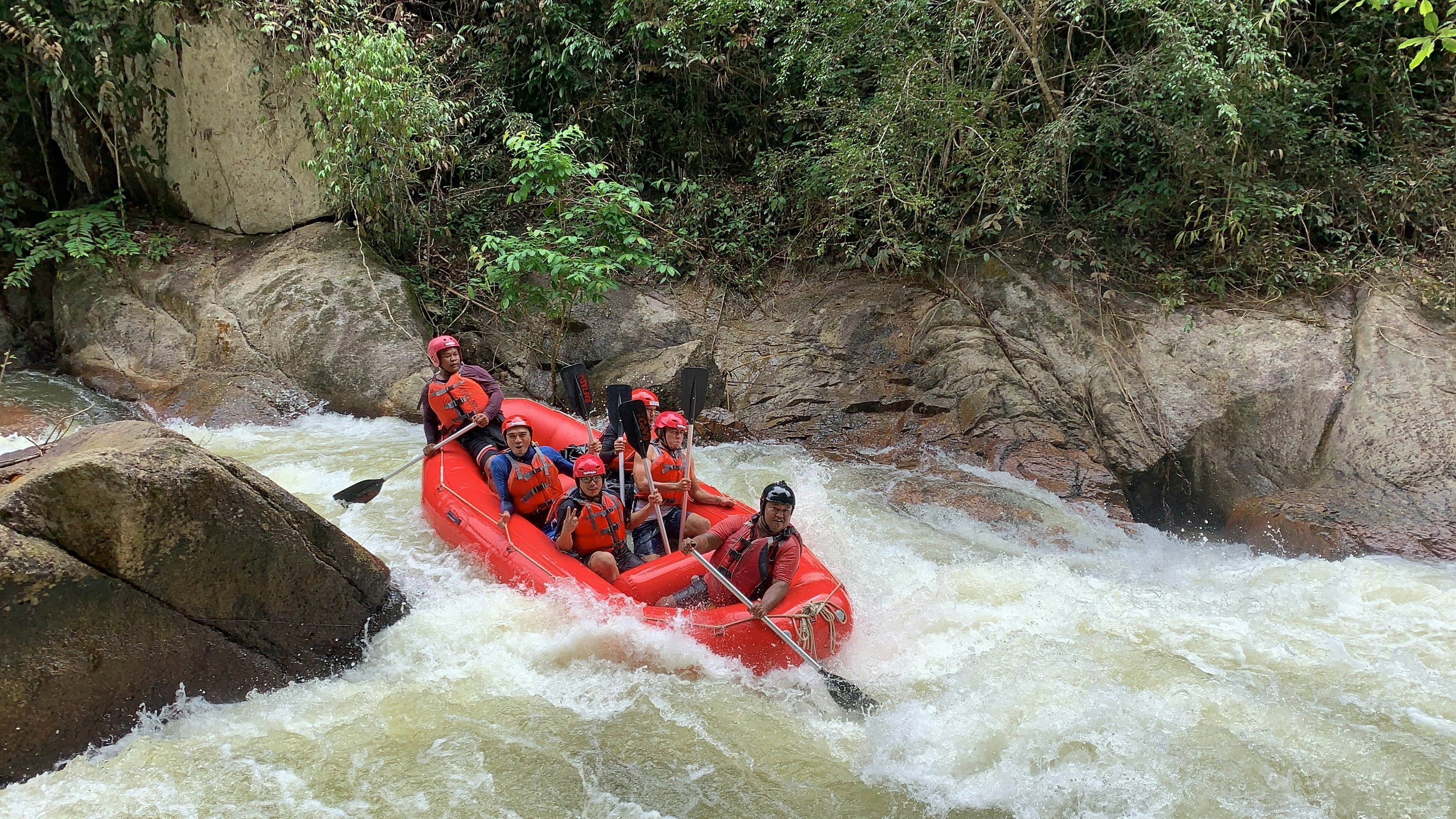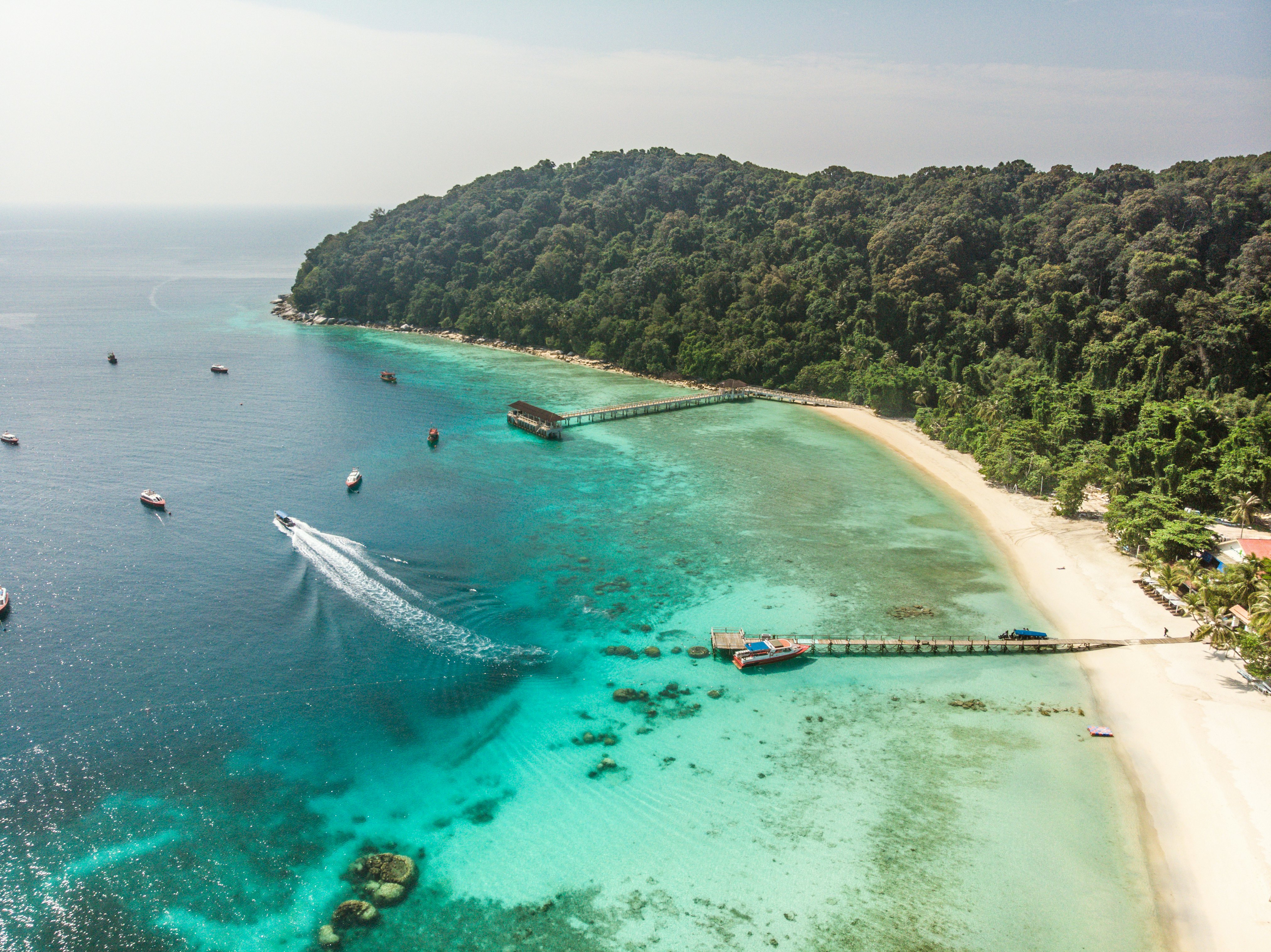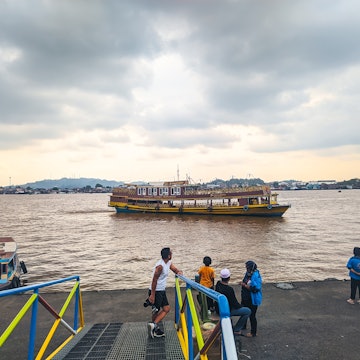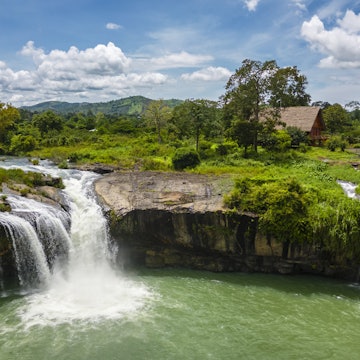

The lush and wonderfully preserved rainforest of Taman Negara is only 3 hours from Malaysia’s capital, Kuala Lumpur. Jasper Neupane/Shutterstock
On either of its beautiful halves, Malaysia beckons with exciting – even thrilling – adventures in nature.
On its peninsular side, a sprinkle of forest-clad tropical islands spills off the 2989 miles (4810km) of beach and mangrove-studded coasts that cut this eel-like strip of land out of the sea. Forming the spine of the peninsula, the little-visited Titiwangsa Mountains offer visitors relatively easy nature treks – as well as a range of offbeat trails to delight the most daring hikers.
Across the South China Sea on Borneo, the East Malaysia states of Sarawak and Sabah boast some of the world’s largest caves, extraordinary dive sites and Mt Kinabalu, the country’s tallest peak and a sacred place to the indigenous Kadazan-Dusun people.
Got your attention yet? Read on for some of the best ways to get up close to Malaysia’s natural wonders.

1. Hike to the heart of the rainforest
Off the peninsula’s northwestern coast, UNESCO-listed Penang Island attracts plenty of foodies and culture vultures – yet relatively few know about its more than 30 excellent hiking trails. Treks of all difficulties crisscross both 2733ft (833m) Penang Hill – a protected UNESCO Biosphere Reserve since late 2021 – and Seberang Perai, the slice of the province on Malaysia’s mainland.
Only 3 hours from the futuristic capital Kuala Lumpur, the 1677-square-mile Taman Negara in Pahang state is the peninsula’s best-protected virgin rainforest. Indeed, at 130 million years old, the tropical forest is one of the oldest in the world – and a principal habitat for elusive and highly endangered Malayan tigers. You can get an easy orientation to this pristine ecosystem on the trail that gently climbs up to Bukit Teresek, or the one down toward the Tahan River and the Lata Berkoh waterfalls.
You need a guide for the two-day Keniam Trail, which includes an overnight stay in a cave and hops between settlements of Orang Asli (Peninsular Malaysia’s 18 aboriginal groups) in a long-tail boat on your return. Yet the park’s most challenging and soul-changing trek is the guided week-long, completely self-supported traverse from Kuala Tahan to 7175ft-high (2187m-high) Gunung Tahan – which aptly translates to “Mount Endurance” and is the highest in Peninsular Malaysia. With loads of luck, you may meet wild elephants, tapirs, sun bears…or at least their fresh footprints.

If a week of camping in the wild is too much, head for the treetop walkway at Sungai Relau near Merapoh, one of Taman Negara’s two other access points (and a caving paradise). It’s a wonderful way to admire Gunung Tahan from afar.
Off the peninsula’s northwestern coast, UNESCO-listed Penang Island attracts plenty of foodies and culture vultures – yet relatively few know about its more than 30 excellent hiking trails. Treks of all difficulties crisscross both 2733ft (833m) Penang Hill – a protected UNESCO Biosphere Reserve since late 2021 – and Seberang Perai, the slice of the province on Malaysia’s mainland.
Don’t miss the Cherok Tokun Forest Reserve near Bukit Mertajam, where you can hike to abandoned dams built during the colonial British era and take in a century-old mengkundor tree (Tetrameles nudiflora) whose extraordinary buttressed roots are taller than the average human.
For a scenic peek over the limestone karst separating Malaysia from the border with Thailand, drive up to the village of Kaki Bukit in often-overlooked Perlis state, and try the easy hike to the 997ft (304m) Wang Kelian Viewpoint. At sunset or sunrise, this vantage point offers a bird’s-eye view above rice fields, green mountains and a dazzling sea of clouds.

2. Explore caves galore
Malaysia is a veritable spelunker’s paradise – and Sarawak is the place to get going underground. With a chamber that could fit 40 Boeing 747 airplanes, the Deer Cave in UNESCO-listed Gunung Mulu National Park in eastern Sarawak is the second-largest cave opening in the world. (The largest is Hang Son Doong in neighboring Vietnam.)
The Niah Caves in nearby Miri are where archeologists unearthed some of the oldest human remains ever found in Southeast Asia, including a Paleolithic human skull at least 40,000 years old (not to mention cave art and wooden boat-shaped coffins, too). In the town of Bau near the state capital of Kuching, two other caves, called Wind and Fairy, are smaller but no less beguiling thanks to their intricate boxwork: thin calcite fins that resemble honeycombs.
Back on the peninsula, the offbeat town of Gua Musang in southern Kelantan offers an adventurous climb up to a large cave nestled inside the limestone massif that towers above the old train station. And in the south of Pahang, the less-visited Gunung Senyum limestone massif near Temerloh is pierced by 19 caves, Gua Terang Bulan, with its tall ceiling and large chamber, being the most impressive.
Don’t forget that the Bukit Kepala Gajah massif – a central attraction in the cluster of historical sites scattered across Perak state’s Lenggong Valley, Malaysia’s fourth UNESCO Heritage Site – has plenty of caves such as Gua Kajang, Gua Teluk Kelawar and Gua Gunung Runtuh. The last is where archaeologists found the remains of 10,000-year-old “Perak Man”: the oldest, most complete human skeleton ever found in Southeast Asia.
Another easy and exciting cave is the 1213ft-long (370m-long) Gua Kelam in Perlis, in the northern reaches of the peninsula. Piercing the bottom of a hill, it’s equipped with a suspension bridge and atmospheric lights, and evokes the era when miners scoured its reaches for iron ore. Once in Perlis, check out the village of Kodiang and the challenging rock climbing on the pinnacles and craggy limestone rock face of Bukit Mok Cun. The formation lies on the border with Kedah state, near the Kodiang station on the main railway line.

3. Dive into Malaysia’s turquoise waters
No less an authority than legendary French oceanographer Jacques Cousteau ranked the marine life of Sipadan, a small volcanic island off Semporna in the southeast of Sabah, among the best in the world. Its surrounding islets of Mabul, Kapalai and Bohey Dulang all have equally gin-clear water, white beaches and endless schools of tropical fish.
Snorkeling and diving are permitted at Sarawak’s first marine park, which was established in 1999 to protect four species of endangered turtle. The park consists of the coastline and waters around four islands: the two Pulau Satang, known as besar (big) and kecil (small); and the two Pulau Talang-Talang, also besar and kecil. Advanced divers can explore four wrecks off Kuching, two of them Japanese World War II warships sunk by the Dutch in the days after the attacks on Pearl Harbor in Hawaii.
The peninsula might be less known for its underwater wonders than Sabah and Sarawak. Yet off its East Coast, beautiful islands like diving-focused Pulau Tenggol are ripe with sites and a corridor for whale-shark passage. Further north, the two Perhentian Islands are more touristy but also one of the least expensive places in the world to get a scuba certification.
From the port at mainland Mersing, ferries depart for some of the other 64 lesser-known and idyllic islands. The eastern side of Tioman Island, off Juara Beach, faces the open ocean and is best for encounters with big fish. Pulau Besar has several resorts, and has been seen regularly on the reality TV program Robinson. Tiny Pulau Rawa has just one resort and a perfect white-powder beach, while Pulau Sibu, closest to the mainland, is a cluster of four islets ringed by walls of offshore coral. Further away, the gorgeous lagoons and offshore pools of secluded Pulau Aur beckon keen swimmers, while the hat-shaped Pulau Tinggi, with the archipelago’s tallest hill, offers even more hours of blissful hiking and snorkeling.

4. Get your adrenaline pumping by rafting or surfing on the water
Beyond diving, Malaysia is excellent for rafting and other water sports. Just south of Perak’s capital Ipoh, you can set out on Grade-1, -2, or -3 white-water rafting excursions on the Kampar River, near the tiny village of Gopeng. You can also abseil off waterfalls, and explore even more caves. Don’t miss the 2-mile-long Gua Tempurung, one of the peninsula’s longest caverns.
Not far away in neighboring Kedah state, the Sedim River offers more sloshing fun, camping and a treetop walk. In Sabah, beginners can start on the Kiulu River and then take on the much more challenging Grade-3 and Grade-4 waters of the Padas River.
With so much coastline, it would be odd not to find at least one suitable spot for surfing – which Malaysians do best at Cherating Bay just north of Kuantan, on the peninsula’s central East Coast. Yet there are surfable waves all along this coast, from Johor to Kelantan states. The best time to catch them is during the northeast monsoon season from October to March.
Intrepid surfers can keep driving further north along the largely empty coast of Terengganu state to such lesser-known beach breaks as Teluk Kalong, near Kijal, and Batu Buruk beach, in state capital Kuala Terengganu.

5. After all that exertion, relax on a perfect beach
Ever-popular Langkawi is not just a geopark featuring stunning, millennial rock formations: it’s also one of the country’s top beach destinations. And with more than 10 different coves and a choice of accommodation ranging from some of Asia’s best resorts to backpacker hostels, Langkawi satisfies every taste and budget.
Further down the peninsula’s West Coast, offbeat Pangkor Island blends soft, curvy beaches with chances to experience the local Malay and Chinese fishing village culture, including visits to boat-making workshops.
For a final dose of pure tuck-your-toes-in-the-sand bliss, head back to the East Coast resort islands of Lang Tengah and Redang, which feel like you stepped onto some of the best atolls in the Maldives.














